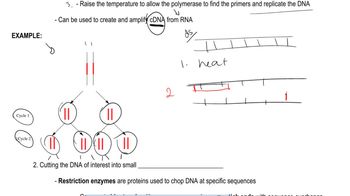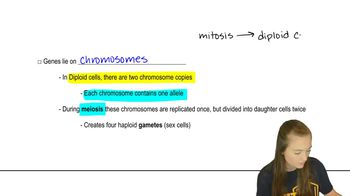Experimental Insight 2.1 describes data, collected by a genetics class like yours, on the numbers of kernels of different colors in bicolor corn. To test the hypothesis that the presence of kernels of different colors in each ear is the result of the segregation of two alleles of a single gene, the class counted 12,356 kernels and found that 9304 were yellow and 3052 were white. Use chi-square analysis to evaluate the fit between the segregation hypothesis and the class results.
Table of contents
- 1. Introduction to Genetics51m
- 2. Mendel's Laws of Inheritance3h 37m
- 3. Extensions to Mendelian Inheritance2h 41m
- 4. Genetic Mapping and Linkage2h 28m
- 5. Genetics of Bacteria and Viruses1h 21m
- 6. Chromosomal Variation1h 48m
- 7. DNA and Chromosome Structure56m
- 8. DNA Replication1h 10m
- 9. Mitosis and Meiosis1h 34m
- 10. Transcription1h 0m
- 11. Translation58m
- 12. Gene Regulation in Prokaryotes1h 19m
- 13. Gene Regulation in Eukaryotes44m
- 14. Genetic Control of Development44m
- 15. Genomes and Genomics1h 50m
- 16. Transposable Elements47m
- 17. Mutation, Repair, and Recombination1h 6m
- 18. Molecular Genetic Tools19m
- 19. Cancer Genetics29m
- 20. Quantitative Genetics1h 26m
- 21. Population Genetics50m
- 22. Evolutionary Genetics29m
3. Extensions to Mendelian Inheritance
Chi Square Analysis
Problem 29
Textbook Question
During your work as a laboratory assistant in the research facilities of Dr. O. Sophila, a world-famous geneticist, you come across an unusual bottle of fruit flies. All the flies in the bottle appear normal when they are in an incubator set at 22°C. When they are moved to a 30°C incubator, however, a few of the flies slowly become paralyzed; and after about 20 to 30 minutes, they are unable to move. Returning the flies to 22°C restores their ability to move after about 30 to 45 minutes.
With Dr. Sophila's encouragement, you set up 10 individual crosses between single male and female flies that exhibit the unusual behavior. Among 812 progeny, 598 exhibit the unusual behavior and 214 do not. When you leave one of the test bottles in the 30°C incubator too long, you discover that more than 2 hours at high temperature kills the paralyzed flies. When you tell this to Dr. Sophila, he says, 'Aha! I know how to explain this condition.' What is his explanation?
 Verified step by step guidance
Verified step by step guidance1
Step 1: Begin by analyzing the observed phenotype. The flies exhibit a temperature-sensitive paralysis phenotype, which is reversible when returned to a lower temperature. This suggests that the condition is likely caused by a mutation in a gene that encodes a protein sensitive to temperature changes.
Step 2: Examine the inheritance pattern of the trait. Among the 812 progeny, 598 exhibit the unusual behavior (temperature-sensitive paralysis) and 214 do not. Calculate the ratio of affected to unaffected flies to determine if the trait follows Mendelian inheritance patterns, such as dominant or recessive inheritance.
Step 3: Consider the lethality observed at high temperatures. The fact that prolonged exposure to 30°C kills the paralyzed flies suggests that the mutation may affect a critical protein required for survival at elevated temperatures. This could indicate a loss-of-function mutation in a gene involved in neural or muscular function.
Step 4: Hypothesize the genetic basis of the condition. Based on the data, the condition could be caused by a single-gene mutation that is either autosomal or sex-linked. The observed ratio of affected to unaffected progeny can help determine whether the mutation is dominant or recessive.
Step 5: Conclude with Dr. Sophila's likely explanation. He might propose that the condition is due to a temperature-sensitive mutation in a gene encoding a protein essential for neural or muscular activity. At high temperatures, the protein misfolds or becomes nonfunctional, leading to paralysis. Returning to a lower temperature allows the protein to refold and restore function.
 Verified video answer for a similar problem:
Verified video answer for a similar problem:This video solution was recommended by our tutors as helpful for the problem above
Video duration:
3mPlay a video:
Was this helpful?
Key Concepts
Here are the essential concepts you must grasp in order to answer the question correctly.
Temperature Sensitivity in Genetics
Temperature sensitivity refers to how certain genetic traits can be influenced by environmental conditions, such as temperature. In this case, the fruit flies exhibit normal behavior at 22°C but become paralyzed at 30°C, indicating that the gene responsible for their movement may be temperature-sensitive, affecting protein function or expression under different thermal conditions.
Recommended video:
Guided course

Genetic Cloning
Phenotypic Variation
Phenotypic variation is the observable differences in traits among individuals, which can arise from genetic differences and environmental influences. The progeny of the fruit flies show a clear phenotypic variation, with 598 exhibiting unusual behavior and 214 not, suggesting a genetic basis for the observed traits and the potential for inheritance patterns.
Recommended video:
Guided course

Genomic Variation
Genetic Inheritance Patterns
Genetic inheritance patterns describe how traits are passed from parents to offspring, often following Mendelian principles. The ratio of progeny exhibiting the unusual behavior suggests a possible dominant or recessive trait, which Dr. Sophila may use to explain the genetic basis of the paralysis observed in the fruit flies under high temperature.
Recommended video:
Guided course

Diploid Genetics
Related Videos
Related Practice
Textbook Question
402
views


